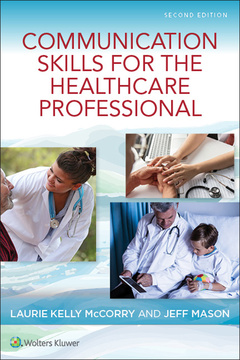Description
Communication Skills for the Healthcare Professional (2nd Ed.)
Authors: McCorry Laurie, Mason Jeff
Language: English
Subject for Communication Skills for the Healthcare Professional:
Publication date: 11-2019
288 p. · 15.2x22.9 cm · Paperback
Withdrawn from sale
288 p. · 15.2x22.9 cm · Paperback
Withdrawn from sale
Description
/li>
Fully updated to reflect the latest changes in the healthcare field, this comprehensive yet compact guide helps nursing and health professions students become strong and confident communicators. Throughout the text, a broad range of examples, role plays, and scenarios from virtually every healthcare field help students master area-specific communication skills, while practical coverage of essential verbal and nonverbal communication skills prepares them for effective practice. The second edition features a new chapter, expanded coverage of social media, and a stronger focus on the soft skills needed for effective practice.
- Buy it as an eBook. Fast, smart, and convenient, today’s eBooks can transform learning. These interactive, fully searchable tools offer 24/7 access on multiple devices, the ability to highlight and share notes, and much more.
- NEW! All-new chapterThe Communication Skills You Need to Land that First Job to help students enter and succeed in a healthcare career.
- NEW! An added section on Electronic Health Records (EHR) in Chapter 10, as well as new material throughout the book on social media, bring this edition fully up-to-date.
- NEW! Stronger coverage of soft skills, such as effective communication with patients and colleagues, professionalism in image and tone, and knowledge of medical law and ethics, prepares students for effective practice in today’s rapidly changing healthcare field.
- Three main sections outline basic communication principles and their uses in clinical and administrative settings.
- Coverage of how to communicate with a wide range of patients including those whose ability may be impacted by anxiety, anger, cultural differences, language differences, visual impairment, hearing impairment, mental or emotional disturbance, age, denial, or confusion, prepares students for on-the-job challenges.
- Chapters on key topics such as cultural sensitivity, adapting communication to a patient's ability to understand, and dealing with other roadblocks, provide techniques students can use to handle challenging situations.
- Role Play boxes give students the opportunity to practice and perfect essential communication skills.
- Clinical Applications offer complex scenarios that help students develop the critical thinking skills needed for practice.
- Chapter-opening Learning Objectives identify the skills students must master, while chapter-ending Objective Review Questions provide quick reviews of the learning objectives.
- Chapter-ending Short Answer Questions allow students to test their understanding of chapter topics.
- End-of-chapter Fundamental Writing Skills sections give student ample opportunity to practice and review grammar, effective paragraph construction, and note-taking strategies.
© 2024 LAVOISIER S.A.S.




